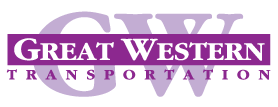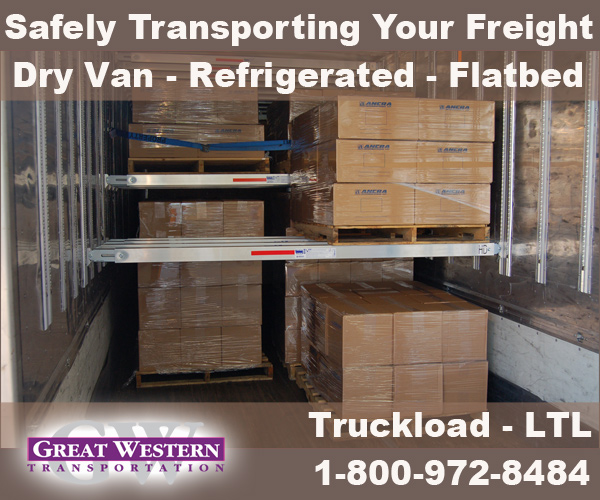Truck transported cargo and freight that is properly secured on a trailer is a fairly straightforward safety concept we can all agree upon. It is expected that freight transported in or on a flatbed trailer or van will stay in place safely, until ready to be removed.
In a worst-case scenario, improperly secured freight may be fatal to the driver, dockworkers or the motoring public. As an example, freight that shifts during transit can fall on top of an unsuspecting driver or dockworker when they open the trailer doors.
Plus of course, the freight must arrive in tact and undamaged when reaching its final destination. Freight should also be secured in such a way as to prevent it from shifting, due to truck turns and sudden stops. If a load shifts enough to move the center of gravity in a trailer, it could make the tractor trailer more likely to roll over if the driver turns too fast.
Other potential costs of improperly secured freight are:
- The consequences of an injury or fatality.
- The business losses a customer incurs if the cargo or service is not delivered.
- The increase on a company’s third-party insurance rates.
- The financial losses of a vehicle on business operations.
To proactively deal with these business losses and liability issues, trucking companies will develop and implement a cargo securing process. Ensure all drivers are adequately trained for the specific type of trailer or van, in addition to the freight they haul. Plus drivers must be completely familiar with all equipment they may encounter or operate.
Cargo securing techniques for dry vans fall in two groups: truckload and less-than-truckload. LTL uses more equipment because they haul more mixed freight, mixed sizes and various shapes, that have to be stacked or arranged to maximize cargo space utilization.
Freight Securement Systems.
So lets cover some of the major categories of cargo securing techniques and the associated equipment.
There are many ways to secure cargo after it has been loaded into a dry van:
- Dunnage bags can be filled with air and then are placed between stacks of cargo. The dunnage bags help prevent cargo from shifting while you’re on the road and are one of the most cost-effective methods of cargo securement. They may also be easily disposed or packed due to their minimal volume since they are filled with air.
- Void fillers are another cost-effective option to secure a load. Void fillers come in a multitude of shapes and sizes, making it a good option for any load.
- Friction mats are made from thick rubber and can prevent freight from sliding on the trailer floor.
- Ratchet straps are perhaps the most common way to secure dry vanloads. They come in hundreds of styles and sizes and can be used to strap down just about anything. They are made from polyester webbing that is lightweight and incredibly strong. Also V boards are used on the side of cargo to avoid strap damage.
- Jack bars are useful for cargo that might tip over, such as barrels, or cargo that might slide, such as carpeting. Jack bars are placed on either side of the trailer’s walls and are small enough to fit anywhere on the trailer.
These are just some of the ways to properly secure the cargo in your dry van. They are all simple to use and are designed to keep the product, and more importantly, you and other drivers, safe.
There are also complete systems dedicated to securing freight and maximizing the volume in a dry van, lets cover some of these next.
Logistics tracks, also called “log” tracks, are metal strips that have indented holes in them. The hook ends of straps, nets, hoops and bars are inserted into the holes. They come in several types, including A, E and O, which describe the holes’ shapes. They can be arranged vertically in support posts and horizontally along the wall and floor. Straps and nets can be attached anywhere from floor to ceiling to keep cargo in place.
Captive beams are semi permanently attached to a trailer’s interior and can be shifted on tracks and paired to support shelving. When not in use, they are stowed in the ceiling.
Thus cargo can be stacked without lower boxes or packages being crushed by weight from on top. These can be combined with various restraints to keep cargo on their respective decks.
Captive beam systems optimize efficient use of trailer cube capacity.
This will allow the trucking company to increase the cargo capacity of their trailers through efficient use of the available trailer cube.
Another option, “load lock” bars, compress against walls. They are only valuable in dry vans when they’re kept near the floor or ceiling because the trailer walls will flex outward. Load lock bars are more commonly used in reefer trailers whose walls are stronger. Load lock bars are also sometimes compatible with e track systems.
Freight is also often secured by systems that are fastened to the floor, as the floor provides greater surface strength than the trailer walls.
Floor tie down points also vary in design. Recessed rings, sometimes called “bull rings,” are used to secure heavy cargo such as steel coils on flatbed trailers. There’s also the F-track with round holes, placed crossways in the floor and ceiling, with vertical bars or hoops inserted to separate loads. Door and window makers use the crossways configurations to keep the somewhat fragile products from leaning against each other. The U.S. Postal Service utilizes a system with stake pockets embedded in floors at equal spacing to hold poles that restrain mail bins and containers.
The company Utility Trailer Manufacturing offers a floor-mounted system called: Adjustable Load Securement System (ALSS). The ALSS consists of a pair of full-length tracks at the outer edges of flats or near walls of vans; each track has a groove into which J-hooked straps are inserted. The straps are then tightened down against loads. ALSS is available in all flatbeds and drop deck trailers. This system allows for unrestricted load securement from the front to the rear rail.
Refrigerated “Reefer” trailers use less cargo securing equipment since food safety regulations require frequent interior sanitizing due to food grade quality regulations. This equates to the nooks and crannies in tie-down points having to be carefully cleaned out and sanitized. Some reefers have short tracks at the rear and use a cargo net across the back of the load to keep it from shifting onto the doors, causing it to fall out when door is opened.
On the other hand heavy haul trucking requires extra heavy-duty equipment for load securement.
Now that we have covered some of the cargo securing systems, we can determine a conclusion. If loads aren’t properly secured in van trailers or flatbed trailers, it’s not because there’s a lack of equipment that serves the purpose.
The trucking company should ensure that fleet vehicles are well maintained mechanically and in appearance. A clean, tidy vehicle is the first step in projecting a positive corporate image to customers and the motoring public.
Cargo Securement Requirements.
The Federal Motor Carrier Safety Administration (FMCSA) provides guidelines as to proper cargo securing
Here is what the FMCSA is about – as from FMCSA official website.
Our Mission
The primary mission of the Federal Motor Carrier Safety Administration (FMCSA) is to reduce crashes, injuries and fatalities involving large trucks and buses.
The FMCSA was established as a separate administration within the U.S. Department of Transportation (DOT) on January 1, 2000, pursuant to the Motor Carrier Safety Improvement Act of 1999. FMCSA is headquartered in Washington, DC and employs more than 1,000 people in all 50 States and the District of Columbia, all dedicated to improving the safety of commercial motor vehicles (CMV) and saving lives.
FMCSA recommendations to truckers are:
- Complete a thorough pre-trip vehicle inspection, including all components and accessories.
- Remove all debris from the vehicle bed or trailer deck. These areas can sustain a certain amount of damage from normal use; make sure they are in good repair.
- A critical precaution is securing a vehicle from movement while it is loaded. The parking brake may be adequate on smaller vehicles, while larger vehicles may require parking chalks.
- Ensure the vehicle is correctly sized if it hauls large or bulky items.
Cargo Inspection, Securing Devices & Systems
As trucking companies under FMCSR regulation 392.9, companies and drivers are required to:
- Distribute and secure freight properly.
- All vehicle freight securing devices (chains, straps, and tarps) and cargo must be secured.
- Drivers must have clear visibility on all sides of the vehicle.
- Drivers must have free movement of their arms and legs.
- Driver must have access to emergency equipment and easy vehicle exit.
- The freight and devices to secure the load must be inspected prior to the beginning trip.
- Inspect the freight within the first 50 miles traveled and adjust securing devices if required.
- Inspect the freight and securing devices during the trip, adjusting if required.
- Re-inspections intervals must occur whenever a change-of-duty status occurs and when the vehicle has been in operation more than three hours or driven 150 miles (whichever occurs first).
States Regulate Vehicle and Axle Weights
Individual states may have both gross vehicle and per-axle weight restrictions. Furthermore, some states may also have cargo-covering requirements. Trucking company staff and drivers must be knowledgeable about the regulations and restrictions in each state company vehicles haul freight through. Heavy haul trucking requires special attention to state axle weight regulations.
In summary, a poorly or overloaded loaded dry van or flatbed trailer can be difficult to operate and can contribute to excessive wear on the equipment and poor fuel economy.
Everyone benefits from a sound cargo securing policy: companies, drivers, customers, and the motoring public.
Let us prove to you that Great Western Transportation is your Premier Trucking Service.
Call us for information about our trucking services or for a rate quote.
Great Western Transportation 5000 Pleasanton Ave, Suite 145 Pleasanton, CA 94566






